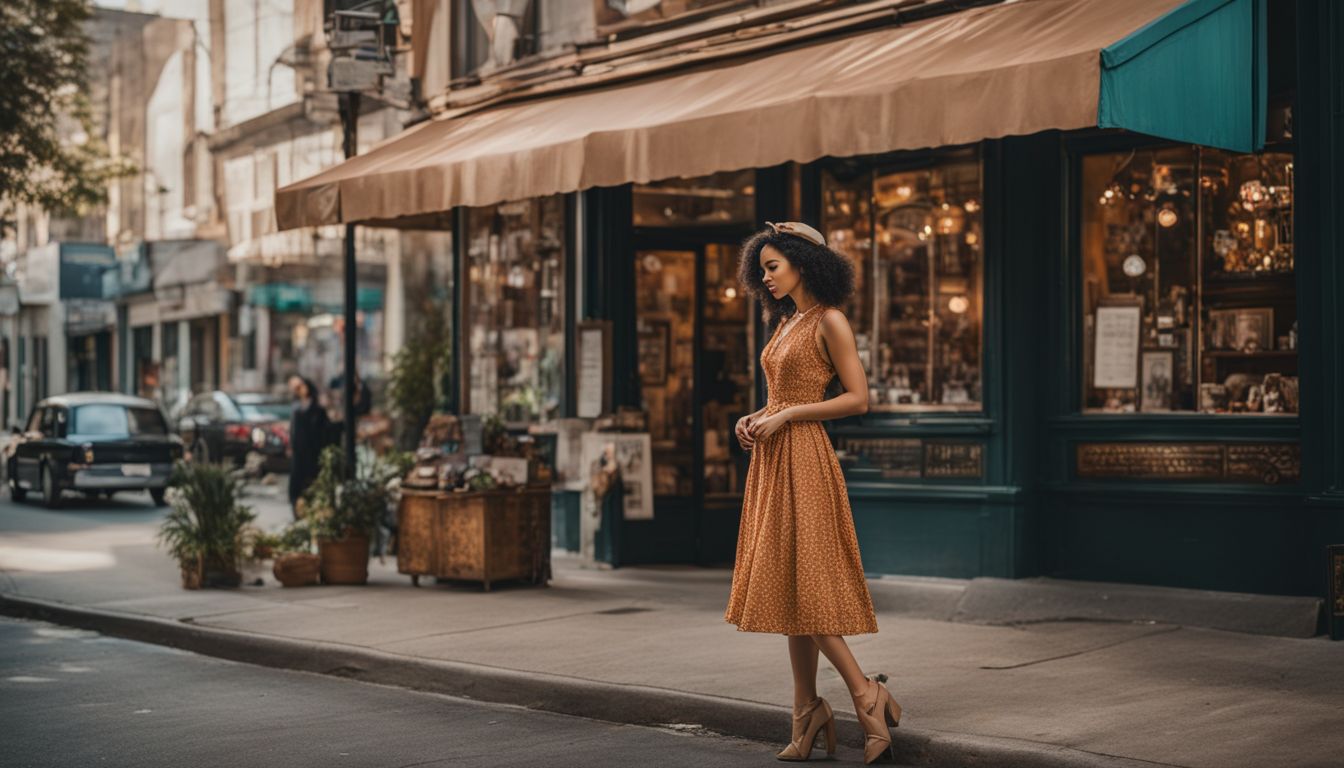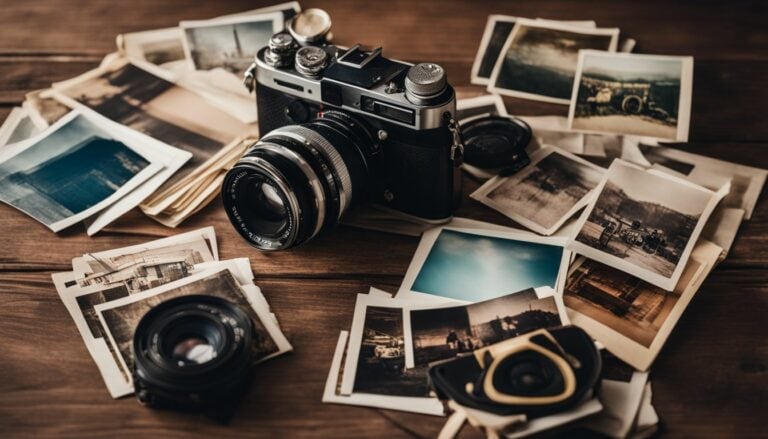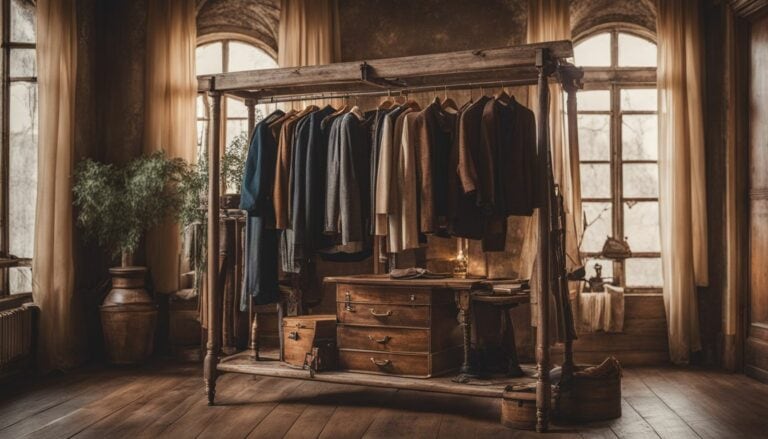Ever wondered why vintage clothing is a trend that never goes out of style? There’s something captivating about the uniqueness and history embedded in garments from a bygone era. In this article, we delve into what exactly defines vintage clothing, its allures, ethical implications, how to find it and care for it – your comprehensive guide to embrace this enduring fashion.
Ready to embark on a journey back in time? Let’s get started!
Key Takeaways
- Vintage clothing refers to garments that are at least 20 years old and reflect the style of a specific era.
- It includes pieces from both high – end designers and mainstream fashion labels.
- Vintage clothing is popular because it offers unique and one-of-a-kind pieces, supports sustainability by reducing waste, and allows for personal style expression.
- You can find vintage clothing at thrift stores, consignment shops, and online platforms. Proper care techniques include cleaning before storing, using acid-free tissue paper, avoiding plastic bags, storing in a cool dry place, handling with care, regularly inspecting for pests, following care instructions on garment labels or consulting professionals if needed.
Definition and Characteristics of Vintage Clothing

Vintage clothing refers to clothing that is at least 20 years old and reflects the style and trends of a specific era. It can include high-end designer pieces or mainstream fashion labels.
Clothing that is at least 20 years old
Clothing that is at least 20 years old gets the label of vintage. These clothes are from a past era but they still exist today. Think of them as time capsules in your closet! They can be from any brand, high-end or not.
Some pieces might even date back to over 100 years ago! This age rule is what sets vintage clothes apart from all others. It does not matter if it’s worn or new, trendy or out-of-date.
As long as an item is 20 years old, it becomes part of the world of vintage fashion.
Reflects the style and trends of a specific era
Vintage clothing lets us step back in time. Each piece tells a story from a specific era. These old clothes show the style and trends of when they were made. For example, 80s vintage items have bold colors and large prints.
Wearing these clothes is like wearing history! Vintage clothing helps us see how people dressed years ago. The fashion of each period had its own charm and vibe. This trip down memory lane makes it fun to wear vintage pieces!
Can be high-end designer or mainstream fashion labels
Vintage clothes come in many types. They can be from big-name designers or common brands. Sometimes, they are items made famous by trend-setters of the past. Other times, they’re just everyday clothes that people loved and wore often.
No matter where they come from, vintage pieces show styles and trends from different eras. These kinds of clothes may belong to top fashion houses like Chanel or Dior. Or they might be from familiar companies like Levi’s or Gap that make clothes for everybody every day.
All types have value because of their history and design quality.
Why Vintage Clothing is Popular

Vintage clothing is popular for its unique and one-of-a-kind pieces, sustainability and ethical considerations, as well as nostalgia and personal style expression.
Unique and One-of-a-Kind Pieces
Vintage clothing offers a treasure trove of unique and one-of-a-kind pieces that you won’t find in modern retail stores. Each item tells a story, reflecting the style and trends of a specific era.
Whether it’s a vintage designer piece or mainstream fashion label, these garments have stood the test of time and provide an opportunity for personal style expression. By wearing vintage clothing, you can stand out from the crowd and embrace your individuality with pieces that are truly special.
Sustainability and Ethical Considerations
Vintage clothing is not only a fashion statement but also a sustainable and ethical choice. By buying second-hand garments, you are participating in the movement towards reducing waste and limiting the harmful impact of fast fashion on the environment.
Vintage clothes offer an alternative to constantly buying new items, as they recycle and give new life to old garments. Additionally, choosing vintage means supporting local thrift stores and small businesses that specialize in selling these unique pieces.
By opting for vintage clothing, you can express your personal style while making a positive impact on the planet.
Nostalgia and Personal Style Expression
Vintage clothing appeals to many people because it evokes feelings of nostalgia and allows for personal style expression. Wearing clothes from a different era can transport us back in time, reminding us of the music, movies, and events that were important to us during that period.
It brings back cherished memories and creates a sense of connection to the past. Additionally, vintage fashion allows individuals to stand out from the crowd by showcasing their unique taste and personality.
By mixing vintage pieces with modern ones, one can create a fashionable look that is truly their own. Vintage clothing provides an opportunity for self-expression and adds an element of individuality to our wardrobes.
Tips for Finding and Caring for Vintage Clothing
Explore thrift stores, consignment shops, and online platforms for a wide selection of vintage clothing. Inspect for quality and condition before making a purchase, and learn proper storage and care techniques to ensure your vintage pieces stay in great shape.
Read more to become a pro at finding and preserving your vintage treasures!
Explore Thrift Stores, Consignment Shops, and Online Platforms
You can find vintage clothing at thrift stores, consignment shops, and online platforms. These places offer a wide range of second-hand clothes from different eras. Thrift stores often have unique and affordable vintage pieces mixed in with other items. Consignment shops specialize in selling high-quality vintage garments on behalf of their owners. Online platforms like Etsy and eBay also have a large selection of vintage clothing for sale. So if you’re looking to add some vintage flair to your wardrobe, check out these options!
Inspect for Quality and Condition
When buying vintage clothing, it is important to inspect the quality and condition of the garments. Vintage clothes have been around for many years, so they may show signs of wear and tear.
Check for any stains, rips, or missing buttons that could affect the overall appearance and functionality of the item. Additionally, pay attention to the fabric’s condition by examining for any fraying or discoloration.
It’s also a good idea to try on the clothing if possible to ensure a proper fit before making a purchase. By carefully inspecting vintage clothing for quality and condition, you can make sure you’re getting a piece that will last and bring enjoyment for years to come.
Inspecting vintage clothing is essential when looking for high-quality pieces with timeless appeal. Take your time to examine each garment thoroughly before purchasing. Look out for any tears or loose threads as they can worsen over time if left unattended.
Inspect the fabric carefully; natural fibers like wool and silk tend to be more durable than synthetic materials such as polyester or rayon. Be aware of potential issues like moth holes or fading colors which might affect both appearance and value of vintage items.
Proper Storage and Care Techniques
To ensure your vintage clothing stays in good condition, it’s important to follow proper storage and care techniques. Here are some tips:
- Clean before storing: Make sure the garments are clean before storing them. This helps prevent stains from setting in and keeps insects away.
- Use acid-free tissue paper: Place acid-free tissue paper between layers of clothing to prevent color transfer and protect delicate fabrics.
- Avoid plastic bags: Don’t store vintage clothing in plastic bags as they can trap moisture and cause mold or mildew growth. Instead, opt for breathable fabric garment bags or acid-free boxes.
- Store in a cool, dry place: Keep your vintage clothing away from direct sunlight, heat sources, and damp areas to prevent fading, discoloration, and damage.
- Handle with care: When handling vintage garments, wash your hands or wear gloves to avoid transferring oils and dirt onto the fabric. Be gentle while folding or hanging the clothing to prevent stretching or tearing.
- Regularly inspect for pests: Check your stored vintage items regularly for signs of pests like moths or beetles. If you spot any infestation, take immediate action to eliminate them.
- Follow care instructions: Read and follow any specific care instructions on the garment labels or consult with a professional cleaner if needed.
- Consider professional preservation: For valuable or fragile pieces, consider getting them professionally preserved by experts who specialize in vintage clothing restoration.
The Future of Vintage Clothing
Vintage clothing is expected to continue gaining popularity and demand as more people appreciate the unique and one-of-a-kind pieces, integrate vintage elements into modern fashion, and recognize the importance of preserving and appreciating fashion history.
Increasing Popularity and Demand
Vintage clothing has experienced a surge in popularity and demand in recent years. Younger generations, like Gen Z and Millennials, are drawn to the unique and nostalgic appeal of older garments.
They appreciate the one-of-a-kind pieces that vintage clothing offers, allowing them to express their personal style in a way that stands out from the crowd. Additionally, vintage clothing is seen as an eco-friendly alternative to fast fashion since it gives new life to old garments and reduces waste.
As a result, there has been a rise in specialized second-hand retail stores that focus on selling vintage clothing. The trend of incorporating old-fashioned styles into modern fashion has also contributed to the increased demand for vintage items.
Integration of Vintage Elements into Modern Fashion
Vintage elements have made a comeback in modern fashion, with designers and fashion enthusiasts incorporating old-fashioned styles and designs into their latest collections. This integration of vintage elements adds a touch of nostalgia and uniqueness to contemporary outfits.
From retro prints and patterns to classic silhouettes, vintage-inspired clothing can be seen on runways, in street style, and even in mainstream retail stores. By blending the best aspects of the past with current trends, fashion lovers are able to create stylish looks that pay homage to earlier eras while still staying relevant today.
Importance of Preserving and Appreciating Fashion History
Preserving and appreciating fashion history is important because it allows us to understand and celebrate the evolution of style over time. By studying vintage clothing, we can gain insight into the cultural, social, and economic influences that shaped different eras.
It helps us appreciate the craftsmanship and attention to detail that went into creating these garments. Additionally, preserving fashion history allows future generations to connect with their heritage and explore fashion trends from the past.
It reminds us that fashion is not just about what’s trendy today, but a reflection of our collective history and identity as well.
Conclusion
Vintage clothing refers to garments that are at least 20 years old and reflect the style of a specific era. It has gained popularity due to its uniqueness, sustainability, and ability to express personal style.
Finding and caring for vintage clothing requires exploration, inspection for quality, and proper storage techniques. As the demand for vintage clothing continues to grow, it is important to preserve and appreciate fashion history while integrating vintage elements into modern fashion trends.
FAQs
1. What is vintage clothing?
Vintage clothing refers to garments that are at least 20 years old and often represent a particular era or style from the past.
2. Where can I find vintage clothing?
You can find vintage clothing in thrift stores, consignment shops, online marketplaces, or specialized vintage boutiques.
3. How do I care for vintage clothing?
To care for vintage clothing, you should follow the care instructions on the label if available, hand wash delicate items, avoid direct sunlight when storing, and consider consulting a professional cleaner for specific stains or repairs.
4. Why is vintage clothing popular?
Vintage clothing is popular because it offers unique styles and designs that cannot be easily found in modern fashion. It also allows people to connect with history and express their individuality through fashion choices.







